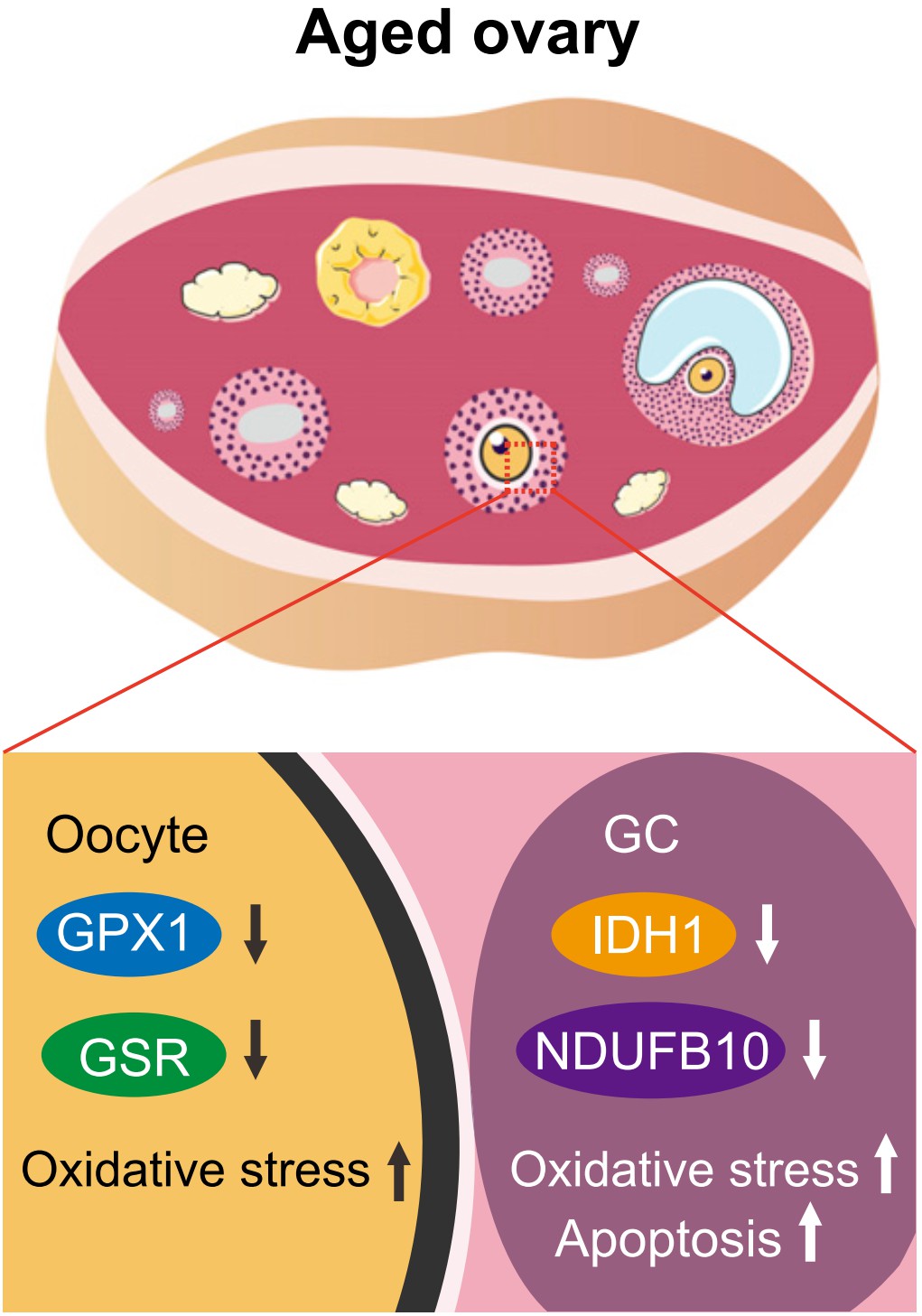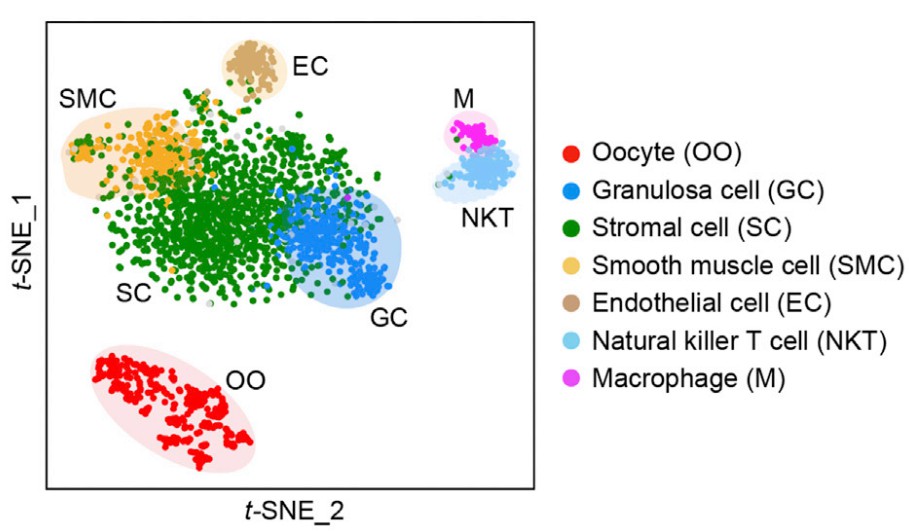Cell. 2020; 180(3): 585-600.e519.
Single-Cell Transcriptomic Atlas of Primate Ovarian Aging
Si Wang 1, Yuxuan Zheng 2, Jingyi Li 3, Yang Yu 4, Weiqi Zhang 5, Moshi Song 6, Zunpeng Liu 7, Zheying Min 8, Huifang Hu 7, Ying Jing 7, Xiaojuan He 9, Liang Sun 10, Lifang Ma 8, Concepcion Rodriguez Esteban 11, Piu Chan 9, Jie Qiao 8, Qi Zhou 12, Juan Carlos Izpisua Belmonte 13, Jing Qu 14, Fuchou Tang 15, Guang-Hui Liu 16
- 1 State Key Laboratory of Membrane Biology, Institute of Zoology, Chinese Academy of Sciences, Beijing 100101, China; State Key Laboratory of Stem Cell and Reproductive Biology, Institute of Zoology, Chinese Academy of Sciences, Beijing 100101, China; National Laboratory of Biomacromolecules, CAS Center for Excellence in Biomacromolecules, Institute of Biophysics, Chinese Academy of Sciences, Beijing 100101, China; Beijing Institute for Brain Disorders, Advanced Innovation Center for Human Brain Protection, National Clinical Research Center for Geriatric Disorders, Xuanwu Hospital Capital Medical University, Beijing 100053, China; University of Chinese Academy of Sciences, Beijing 100049, China.
- 2 Beijing Advanced Innovation Center for Genomics, College of Life Sciences, Peking University, Beijing 100871, China; Biomedical Institute for Pioneering Investigation via Convergence, Ministry of Education Key Laboratory of Cell Proliferation and Differentiation, Beijing 100871, China; Peking-Tsinghua Center for Life Sciences, Academy for Advanced Interdisciplinary Studies, Peking University, Beijing 100871, China.
- 3 State Key Laboratory of Membrane Biology, Institute of Zoology, Chinese Academy of Sciences, Beijing 100101, China; National Laboratory of Biomacromolecules, CAS Center for Excellence in Biomacromolecules, Institute of Biophysics, Chinese Academy of Sciences, Beijing 100101, China; Beijing Institute for Brain Disorders, Advanced Innovation Center for Human Brain Protection, National Clinical Research Center for Geriatric Disorders, Xuanwu Hospital Capital Medical University, Beijing 100053, China; University of Chinese Academy of Sciences, Beijing 100049, China.
- 4 Department of Obstetrics and Gynecology, Center for Reproductive Medicine, Peking University Third Hospital, Beijing 100191, China; Stem Cell Research Center, Peking University Third Hospital, Beijing 100191, China.
- 5 National Laboratory of Biomacromolecules, CAS Center for Excellence in Biomacromolecules, Institute of Biophysics, Chinese Academy of Sciences, Beijing 100101, China; Beijing Institute for Brain Disorders, Advanced Innovation Center for Human Brain Protection, National Clinical Research Center for Geriatric Disorders, Xuanwu Hospital Capital Medical University, Beijing 100053, China; University of Chinese Academy of Sciences, Beijing 100049, China; Institute for Stem cell and Regeneration, CAS, Beijing 100101, China; Disease Genomics and Individualized Medicine Laboratory, Beijing Institute of Genomics, Chinese Academy of Sciences, Beijing 100101, China.
- 6 State Key Laboratory of Membrane Biology, Institute of Zoology, Chinese Academy of Sciences, Beijing 100101, China; University of Chinese Academy of Sciences, Beijing 100049, China; Institute for Stem cell and Regeneration, CAS, Beijing 100101, China.
- 7 State Key Laboratory of Stem Cell and Reproductive Biology, Institute of Zoology, Chinese Academy of Sciences, Beijing 100101, China; University of Chinese Academy of Sciences, Beijing 100049, China.
- 8 Department of Obstetrics and Gynecology, Center for Reproductive Medicine, Peking University Third Hospital, Beijing 100191, China.
- 9 Beijing Institute for Brain Disorders, Advanced Innovation Center for Human Brain Protection, National Clinical Research Center for Geriatric Disorders, Xuanwu Hospital Capital Medical University, Beijing 100053, China.
- 10 The MOH Key Laboratory of Geriatrics, Beijing Hospital, National Center of Gerontology, Beijing 100730, China.
- 11 Gene Expression Laboratory, Salk Institute for Biological Studies, La Jolla, California, United States of America.
- 12 State Key Laboratory of Stem Cell and Reproductive Biology, Institute of Zoology, Chinese Academy of Sciences, Beijing 100101, China; University of Chinese Academy of Sciences, Beijing 100049, China; Institute for Stem cell and Regeneration, CAS, Beijing 100101, China.
- 13 Gene Expression Laboratory, Salk Institute for Biological Studies, La Jolla, California, United States of America. Electronic address: belmonte@salk.edu.
- 14 State Key Laboratory of Stem Cell and Reproductive Biology, Institute of Zoology, Chinese Academy of Sciences, Beijing 100101, China; University of Chinese Academy of Sciences, Beijing 100049, China; Institute for Stem cell and Regeneration, CAS, Beijing 100101, China. Electronic address: qujing@ioz.ac.cn.
- 15 Beijing Advanced Innovation Center for Genomics, College of Life Sciences, Peking University, Beijing 100871, China; Biomedical Institute for Pioneering Investigation via Convergence, Ministry of Education Key Laboratory of Cell Proliferation and Differentiation, Beijing 100871, China; Peking-Tsinghua Center for Life Sciences, Academy for Advanced Interdisciplinary Studies, Peking University, Beijing 100871, China. Electronic address: tangfuchou@pku.edu.cn.
- 16 State Key Laboratory of Membrane Biology, Institute of Zoology, Chinese Academy of Sciences, Beijing 100101, China; National Laboratory of Biomacromolecules, CAS Center for Excellence in Biomacromolecules, Institute of Biophysics, Chinese Academy of Sciences, Beijing 100101, China; Beijing Institute for Brain Disorders, Advanced Innovation Center for Human Brain Protection, National Clinical Research Center for Geriatric Disorders, Xuanwu Hospital Capital Medical University, Beijing 100053, China; University of Chinese Academy of Sciences, Beijing 100049, China; Institute for Stem cell and Regeneration, CAS, Beijing 100101, China. Electronic address: ghliu@ioz.ac.cn.

Molecular mechanisms of ovarian aging and female age-related fertility decline remain unclear. We surveyed the single-cell transcriptomic landscape of ovaries from young and aged non-human primates (NHPs) and identified seven ovarian cell types with distinct gene-expression signatures, including oocyte and six types of ovarian somatic cells. Indepth dissection of gene-expression dynamics of oocytes revealed four subtypes at sequential and stepwise developmental stages. Further analysis of cell-type-specific aging-associated transcriptional changes uncovered the disturbance of antioxidant signaling specific to early-stage oocytes and granulosa cells, indicative of oxidative damage as a crucial factor in ovarian functional decline with age. Additionally, inactivated antioxidative pathways, increased reactive oxygen species, and apoptosis were observed in granulosa cells from aged women. This study provides a comprehensive understanding of the cell-type-specific mechanisms underlying primate ovarian aging at single-cell resolution, revealing new diagnostic biomarkers and potential therapeutic targets for age-related human ovarian disorders.
view this paper in scRNA-Seq database


